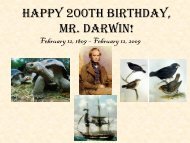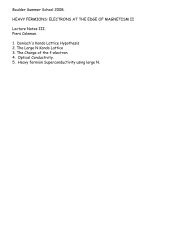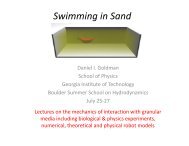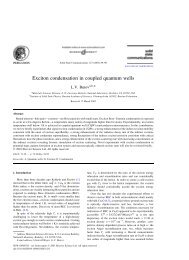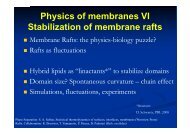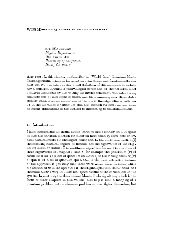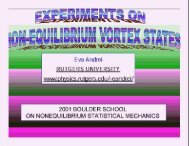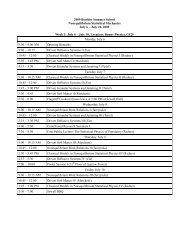Molecular motors I
Molecular motors I
Molecular motors I
You also want an ePaper? Increase the reach of your titles
YUMPU automatically turns print PDFs into web optimized ePapers that Google loves.
<strong>Molecular</strong> <strong>motors</strong> IM. D. BettertonDepartment of PhysicsUniversity of Colorado at Boulder
<strong>Molecular</strong> <strong>motors</strong>Key property: motionMotor protein (or protein complex)Able to generate force and therefore do work<strong>Molecular</strong> basis of biological motility
Biological role of molecular <strong>motors</strong>Basis of biological motilityCell divisionCell motionTransport within cellsGrowthMuscle contraction
Outline: part IEnergy transductionExample: kinesin on microtubuleSingle-molecule experimentsForce and energy scalesEfficiencyReynolds numberThermal fluctuationsHeating
Energy transductionMotion and work requires energy sourceEnergy transductionConversion of one form of energy (e.g., potentialenergy of a chemical bond) to another (e.g.,motion)Typical fuel: ATP hydrolysis
ATP hydrolysisAdenosine triphosphateCommon fuel in cellsATP hydrolysis toADP+P iRemove one phosphate(add water)Negative charges moveaparthttp://hyperphysics.phy-astr.gsu.edu/hbase/biology/atp.html
Problem #1Protein transport in neuronsSpine to fingertip distance: 1 mTypical protein size: 3 nm6 nm
SolutionSpecialized intracellular transport betweencenter and edge of cellHighways: microtubules20-nm filamentsTransporter: kinesin“Walks” onmicrotubules
Kinesin in vivoMichael Welte, http://www.bio.brandeis.edu/weltelab/movies/live.mov
Kinesin in vitroSingle kinesin attached to beadJeff Gelles, http://www.bio.brandeis.edu/~gelles/kamppnp/index.html
Single-molecule experimentsApply force to beadusing optical trapForce clamp =constant forceMeasure beadposition as kinesinmovesVisscher, Schnitzer and Block, Nature 400, 184 (1999)
Single-molecule experimentsVelocity saturates asATPconcentrationincreases=>Saturating kineticsMaximum velocitydepends on loadforceVisscher, Schnitzer and Block, Nature 400, 184 (1999)
Single-molecule experimentsMeasure forcevelocityrelationshipResult varies withATPconcentrationVisscher, Schnitzer and Block, Nature 400, 184 (1999)
SummaryEnergy from ATPExample: kinesin on microtubuleForce and energy scales: pN, nm, pN nmEfficiency: ~1Reynolds number: ~0Thermal fluctuations: importantHeating: ~0
Outline: part 2Survey of motor phenomenaSpindle assemblyStereocilia membrane tensionCutting up collagenUntangling DNA
Newt cellsProblem #2Mitotic spindle organizationMicrotubules-greenSpindle polesmagentaChromosomes-blueKinetochores-yellowKeratin-redAlexey Khodjakov, Laboratory of Cell Regulation,http://www.wadsworth.org/databank/feat-99-12-hq.jpg
Eg5Tetrameric kinesinCan bind two MTssimultaneouslyMoves towards + endsof both MTsSlides apartantiparallel MTsHelps organizespindleValentine, Fordyce and Block, Cell Division 1:31 (2006)
Disruption of Eg5Mammalian cellTreated withmonastrolKills Eg5 functionLeads to monopolarspindleNo antiparallel MTsTarun Kapoor, http://www.kapoorlab.com/images/research_2_fig4.gif
Eg5 current understandingQualitative model in placeFirst single-molecule experiments doneNo quantitative theory
Problem #3Muscle contractionThin filaments: actinpolymer bundlesThick filaments:myosin motorbundlesContraction: Motorsgrab and pullhttp://www.ivy-rose.co.uk/Topics/Muscles/Sliding-Filament_Theory.jpg
Thin and thick filamentsMyosin <strong>motors</strong>are activecross bridgesbetween theactin filamentshttp://fig.cox.miami.edu/~cmallery/150/neuro/sf43x16.jpg
Crossbridge model of myosinMyosin headchangesconformationDepends onnucleotidebindingmotionhttp://www.bms.ed.ac.uk/research/others/smaciver/Cycle.gif
Inner ear containsthe basilarmembraneHair cells sit onbasilar membraneHair cells detectvibrations usingstereociliaProblem #4Hair cells and myosin VIhttp://www.ohsu.edu/ent/gen/haircells.jpg
StereociliaMotion of stereociliaTriggers mechanicallysensitive ionchannel openingCauses polarization ofthe cell and nerveimpulsehttp://www.du.edu/~kinnamon/3640/hearing/matthews18.4.jpg
Stereocilia and myosin VIDefective myosin VIleads to deafnessand balanceproblemsProposed role:tension membranebetween stereociliaMay act as motor andclamphttp://www.bio.umass.edu/vidali/web/cell_motil/myosin_vi_4.jpg
Myosin VI modelDifferent kinetics andbinding with loadProposed model:No/low load: steppingLoad: anchoringAltman, Sweeney and Spudich, Cell 116, 737 (2004)
Collagen fibrils:Extracellular matrix(ECM)Connective tissue25% of mammalianproteinMonomer is 300 nmlongProblem #5Collagen cuttinghttp://wwwfac.mcdaniel.edu/Chemistry/CH3321JPGs/Proteins/Collagen.jpg
CollagenaseMotor protein: moves with biasMoves on and cuts up collagenfibrilsDoes not consume ATPRequires proteolysis of collagenSaffarian et al., Science 306, 108 (2004)
Brownian ratchet:Burnt bridges model1D diffusion on filamentCleave filament atspecific siteAlways end up to rightof cleavage siteCan’t jump gapsCan switch to otherfilamentSaffarian et al., Science 306, 108 (2004)
Problem #6Dealing with DNA tanglesLength of DNAVirus: 20 μmHuman: 2 meters
DNA management exampleDNA TopoisomeraseEats “topoisomers”Undoes tanglesMechanism of Topoisomerase IIBind two strands of DNACut one strandPass other strand through cutSeal cutJoaquim Roca Bosch, http://www.cid.csic.es/homes/roca/TOPOII.html
Single-molecule Topo II experimentsPull on DNATwist DNAMeasure:LengthElasticity/TwistelasticityStrick et al., Physics Today, February 1997Action of singleproteins



